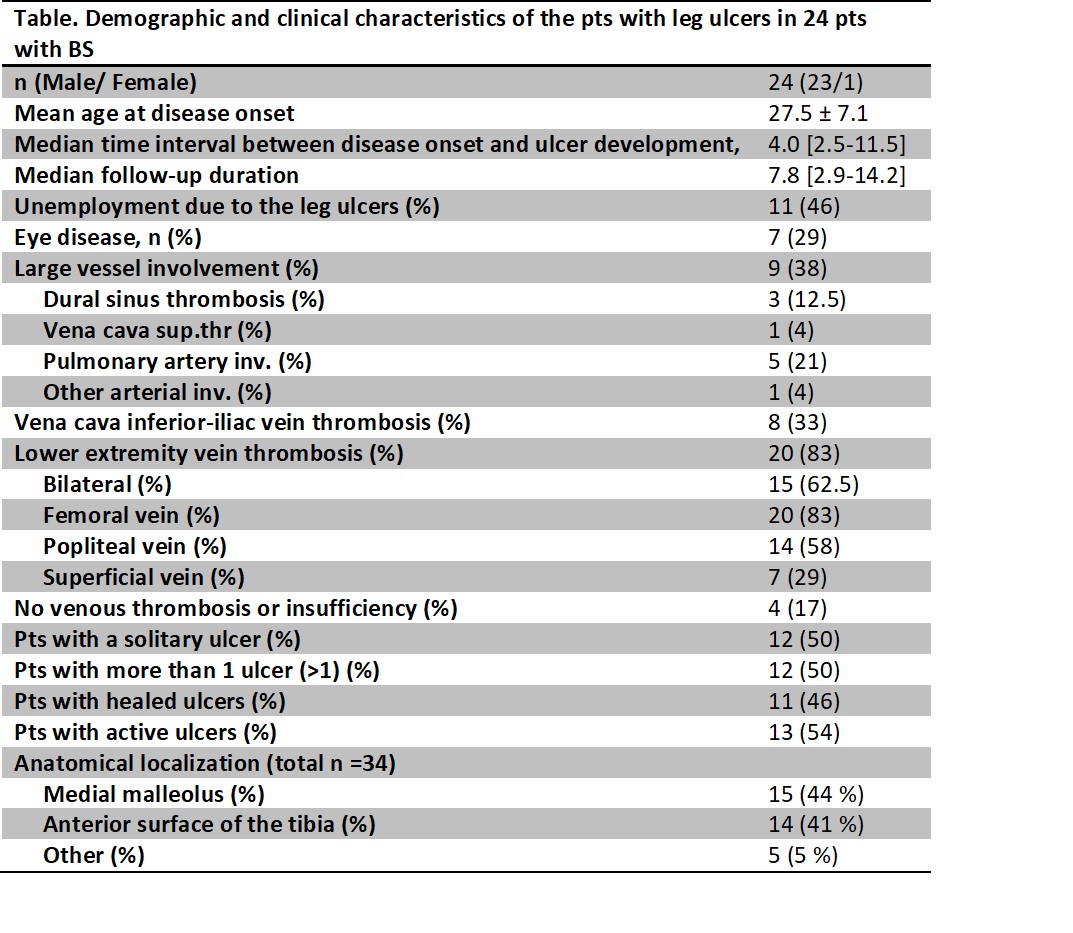Session Information
Date: Monday, October 22, 2018
Title: Vasculitis Poster II: Behҫet’s Disease and IgG4-Related Disease
Session Type: ACR Poster Session B
Session Time: 9:00AM-11:00AM
Background/Purpose: Formal experience with leg ulcers in Behcet’s syndrome (BS) is limited. It is a relatively rare complication that can be seen during the course of mainly post-thrombotic syndrome. They can be difficult to manage and cause disability leading to unemployment and severe impairment in quality of life. In this observational survey, we aimed to describe clinical characteristics of pts with leg ulcers.
Methods: A total of 24 pts (23 M/ 1F) that were seen in our out-patient BS clinic between May 2016 and Jan 2018 were evaluated with the help of a standardized questionnaire. Venous Doppler US and if necessary abdominal CT were used to evaluate localization of venous involvement. Biopsies were done if needed. Medical and other interventional treatments were recorded.
Results: The mean age at disease onset was 27.5 ± 7.1 yrs (Table). The median time interval between the disease onset and ulcer development was 4.0 [2.5-11.5] yrs. The median follow-up was 7.8 [IQR: 2.9-14.2] yrs. Eleven (46 %) were unemployed due to leg ulcers. Venous involvement was present in 20 pts (83 %). Lower extremity vein thrombosis was present in all 20. It was mostly bilateral (15/20). The same 9/20 pts had other large vessel involvement. Four pts did not have any venous thrombosis or insufficiency. Histopathologic studies could be done in 3 and showed features of necrotizing vasculitis in 2 and venous stasis in the 3rd. Twelve pts (50 %) had solitary ulcers while the remaining had 2 or more. We observed a total of 34 ulcers in 24 pts. They were mostly found around the medial malleolus (15/34) and the anterior surface of the tibia (14/34). Five pts had leg ulcers at unusual places such as lateral malleolus (n=2), popliteal fossa (n=1) and posterior surface of the tibia (n=2). Immunosuppressives including azathioprine, cyclophosphamide, interferon-alpha, infliximab and corticosteroids were used. Iloprost infusions were given in 13 (54 %) for a median duration of 6 mo. Additionally, larvae of Lucilia sericata were tried in 9 pts. Skin graft insertion was used in 2 pts, however, was successful only in 1. 17 ulcers in 11 (46 %) pts healed in a median 24 mo [IQR: 9- 78]. In the remaining 13 (54 %) pts 17 ulcers remained unhealed for a median 7 yrs [IQR: 5- 11], despite all treatment. The mean age at BS onset was significantly younger (24.4± 5.4 vs 30.4 ±7.3 yrs; p < 0.05) and the median time between disease onset and ulcer development was significantly shorter (3 [IQR: 1-4.5] vs 10 [IQR: 4-14 yrs, p< 0.05] in pts with the healed ulcers. There were no apparent associations with the type of management and the severity of venous involvement.
Conclusion: Leg ulcer develops mainly due to venous disease in the lower extremities. Peripheral arterial occlusive disease seems to be rarely associated. Leg ulcers may cause unemployment and be resistant to treatment. Ulcers that appear early during the disease course heal faster and are more responsive to treatment.
To cite this abstract in AMA style:
Ozguler Y, Kutlubay Z, Dikici AS, Melikoglu M, Mat C, Yazici H, Seyahi E. Leg Ulcers in Behçet’s Syndrome: An Observational Survey in 24 Patients [abstract]. Arthritis Rheumatol. 2018; 70 (suppl 9). https://acrabstracts.org/abstract/leg-ulcers-in-behcets-syndrome-an-observational-survey-in-24-patients/. Accessed .« Back to 2018 ACR/ARHP Annual Meeting
ACR Meeting Abstracts - https://acrabstracts.org/abstract/leg-ulcers-in-behcets-syndrome-an-observational-survey-in-24-patients/

